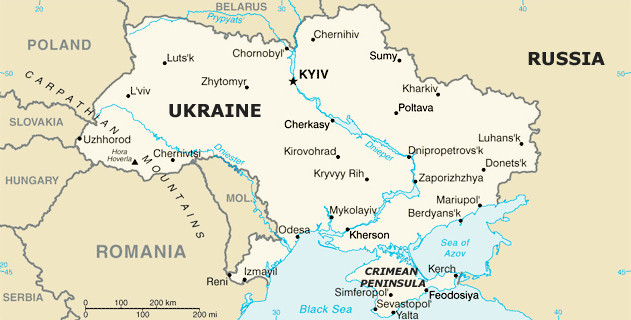Fragile calm holds in East Ukraine before four-way peace talks in Paris

(Business New Europe – bne.eu – Graham Stack in Kyiv – October 2, 2015)
Hopes for an end to 18 months of fighting in eastern Ukraine hinged on a meeting of the leaders of France, Germany, Ukraine and Russia in Paris on October 2, with breakthrough prospects enhanced by a recent ceasefire and withdrawal of tanks and other weapons from the front lines.
In a telephone call between Ukrainian President Petro Poroshenko, German Chancellor Angela Merkel and French President Francois Hollande, the leaders welcomed the signing of a new agreement to pull back weapons from the Donbas region, according to a statement posted to Poroshenko’s website on October 1.
The Paris meeting is hoped to “push towards a durable and full ceasefire in Donbas” and provide “guaranteed access by OSCE monitors to the whole area, including the Russian-Ukrainian border”, Interfax Ukraine quoted Kostiantyn Yeliseyev, deputy head of the Poroshenko’s administration, as saying.
The return of control of the Russian-Ukraine border in the rebel-held territories to Kyiv is the ultimate step envisaged by the Minsk peace agreement updated in February. This would follow local elections held later in October under Ukrainian law in areas controlled by pro-Moscow separatists fighting the pro-Western government in Kyiv.
Overshadowed by Syria
A relatively effective month-long ceasefire has boosted hopes that the Paris summit with participation of Russian President Vladimir Putin can bring a permanent end to the fighting, which has claimed more than 8,000 lives since April 2014.
Putin has been heavily involved in the talks to resolve the conflict, which Western governments say is being deliberately stoked by Russia to hamper Ukraine’s efforts to integrate with the EU and Nato. Russia denies it has supplied the separatist forces with troops and weapons. However, Russia’s newly initiated air assault on Syrian opposition and rebel forces threatened to overshadow the Paris event.
As Russian warplanes bombed Syrian opposition and Islamic State (IS) targets on October 1, the Kremlin kept comments about its expectation from the Paris meeting to a minimum. “There’s only one thing we expect, namely, that some kind of progress in terms of implementation of the Minsk accords will be made,” Putin’s spokesman Dmitry Peskov said.
“Along with the agreements that give grounds for definite optimism, we’re still stating a certain stalemate in the implementation of the Minsk accords,” Peskov added.
A key point of Russian insistence will be the accordance of a special status of the separate territories in the Lugansk and Donetsk regions, as per a law already adopted by the Ukrainian parliament, as well as the region’s right to hold its own polls later in October when the rest of Ukraine holds local elections.
Meanwhile, Merkel and Hollande will both take the opportunity to question Putin directly on his Syria strategy when they sit down separately ahead of the main summit.
On September 30, Putin received fast-track parliamentary approval to use military force abroad. Within hours, Russian military jets and helicopters that had been sent to Syria in recent weeks were pounding forces opposed to Syrian President and Russian ally Bashar al-Assad.
While Putin has called for an international coalition against terrorism and IS forces in Syria in particular, Western intelligence reports said the strikes targeted not the IS but other opposition forces. Also addressing the United Nations General Assembly in New York on September 29, US President Barack Obama said there could be no support for Assad’s regime given its use of heavy weapons on the civilian population.
Inundated by a flood of refugees from the region, the French and German leaders will use the opportunity in Paris to probe Russia’s intentions in Syria, and what the repercussions may be.
Poroshenko, in turn, will try to keep attentions at the four-way meeting focused on the civil war that has ravaged the eastern industrial heartland of his country
Quiet for now on the eastern front
The new ceasefire follows the rebels’ signing of agreements on the removal of remaining weapons with calibre of less than 100mm from the demarcation line on September 30 and October 1. Observers from the Organisation for Security and Co-operation in Europe (OSCE) will monitor the process.
Heavier weaponry was withdrawn from the frontlines under the terms of the Minsk agreements signed in February 2015. But the agreement has been routinely violated by firing from mortars and tanks as well as automatic gunfire, causing frequent if low casualties.
The signing of the new agreements appeared to have had immediate effect. “No cases of opening fire were reported in the temporarily occupied territory of Donbas in the last twenty four hours,” the Ukrainian military said in a statement in the evening of October 1.
On the same day, however, the leader of the breakaway self-styled Donetsk People’s Republic, Oleksandr Zakharchenko, accused Kyiv’s forces of firing on the city of Donetsk, and announced a temporary suspension of the withdrawal of weaponry. Drones flown by the OSCE Special Monitoring Mission confirmed a concentration of heavy weapons on DPR territory on September 29 and 30 “in violation of the respective withdrawal lines”, as reported by Interfax Ukraine.
Recent progress in ending the conflict also results from the passing of controversial legislation that provides for special status of the rebel-held territories, as required by the Minsk agreement.
The Russian-backed rebels subsequently announced they would hold local elections as set down in the Minsk agreements, albeit on different dates from Ukrainian local elections slated for October 25. Kyiv has said it will not recognise the elections unless they are held under Ukrainian law.
